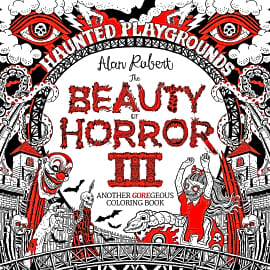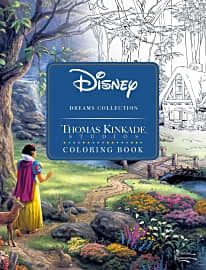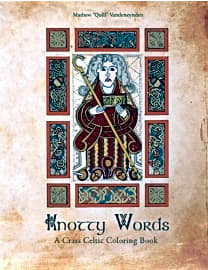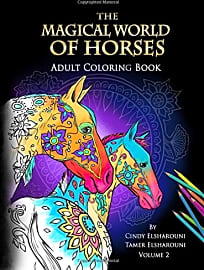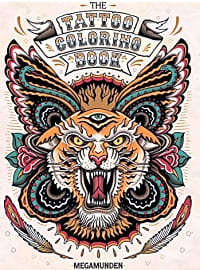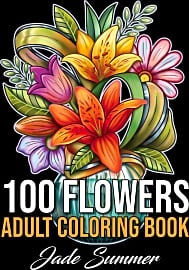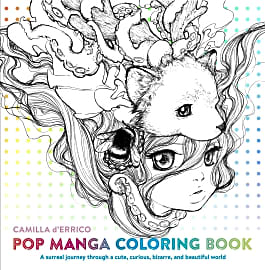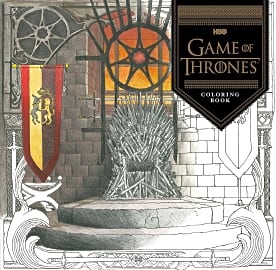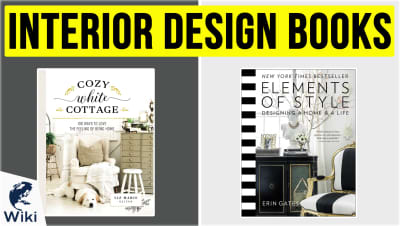The 10 Best Adult Coloring Books

This wiki has been updated 37 times since it was first published in July of 2015. If you catch yourself fighting the urge to take away your children's coloring books and yell at them for not doing it right, it might be time to get a few of your own. These adult versions are great for improving concentration, unleashing creativity, and relieving stress — and they're way cheaper than therapy. There are choices centered around many themes, so there is one for every taste. When users buy our independently chosen editorial picks, we may earn commissions to help fund the Wiki.
Editor's Notes
February 29, 2020:
We've looked for adult coloring books with a wide range of themes, and with varying intricacy levels. Most are fine for mature children or teens, as well, with the exception of two, The Beauty of Horror 3 and Knotty Words. These have decidedly adult imagery and language, so you may want to keep them for your eyes only.
As for top choices, we've added the newer Lost Ocean in place of Secret Garden. It's hard to go wrong with anything from Johanna Basford, and this elegant "Inky Adventure" is no exception. We've opted to keep Yellowstone National Park, a perennially popular choice, not only for the stunning artwork but also because the designs are only printed on one side of each page — so you're free to use even the heaviest of markers and pens. Nature lovers might also appreciate 100 Flowers, while those who enjoy princesses and enchantment might consider the Disney Dreams Collection from the work of beloved painter Thomas Kinkade. The latter almost requires an artist's touch, however, as some detail needs to be filled in and there are many tiny areas to shade and color. Using a high-quality marker or colored pencil set will help.
Special Honors
Hermès Petits Felins While the drawings are elegant and refined, the price of the Hermès Petits Felins is certainly over the top. Fashionistas will appreciate the artwork, however, which is taken from the scarves and sketches of French naturalist Robert Dallet, known in part for his drawings of cats ("petits felins" is French for "little cats"). hermes.com
Color Me Book Custom A Color Me Book Custom costs a pretty penny, but it features illustrations from pictures you've uploaded, so it's completely unique to you. It would make a thoughtful, personalized gift, or perhaps a treat for yourself that'll help you feel closer to your loved ones or pets. mycolormebook.com
13 Unexpectedly Great Times to Color
If things go well, you'll realize all the coloring you've been missing out on and will never return to the time-sucking evils of social media.
We all have busy lives, but wouldn't it be nice to spend some time relieving that stress and business with some coloring? To help you find the time, we made a list of times and situations that you could try your hand at some therapeutic coloring to stay chill.
On the phone. The next time you're on the phone with your mother, distract yourself from her longwinded complaints about her back and the overly detailed update about that family drama between your uncles with some coloring. Better yet, stop that stress at its source and send your mother a coloring book too. Maybe even suggest you color together for some authentic bonding time. This one also works for the next time you're on the phone with your mother-in-law while she's planning her next visit to your home: just take a deep breath, color, and remember that there's at least one place in your life in which you can find colorful peace.
In the waiting room. Bring your adult coloring book to your next doctor appointment and work on it in the waiting room. Maybe the receptionists will give you funny looks, but I promise they've seen weirder things, and plus, your doctor might give you bonus points for your newfound therapeutic relief.
In the subway. Like the above point, but in the subway. If you take the subway often, then you definitely know people have seen weirder things than your adult coloring, so color proudly. Avoid choosing particularly intricate images to color while on the subway, because you may have a hard time staying in the lines with all of the subway's bumps and jolts.
While on hold with your insurance company. I don't know about you, but I spend a lot of time on hold with my insurance company, and what better time to color? Try coloring to the rhythm of the hold music as you battle the worst of bureaucracies. If you finish coloring a whole page before you get taken off of hold, you can mention that in your formal complaint to the company, or when describing the terrible experience of how you were on hold forever to your friends.
While watching TV. Make watching TV a slightly more engaging activity by coloring at the same time! Not only will you face the wonderful challenge of multitasking, but you'll also have the challenge of following along with whatever you're watching primarily by listening while your eyes are elsewhere. Or, for a very different challenge, try coloring while keeping your eyes engaged with the TV and see what happens. You might be able to guess that it won't be pretty.
While babysitting. Show the kids you're babysitting that you're a kid at heart by bringing your adult coloring book to your babysitting session. This way, you won't have to pretend to enjoy coloring their really easy coloring books with them, and instead can actually enjoy something a little bit harder. Coloring with the kids will make you seem relatable in a way that could make the babysitting session a little bit easier, but we can't guarantee it. Of course, it could also have the adverse effect of causing them to mock you for being a grownup who colors, and because we all know how brutally honest kids are, it might sting.
In the bath. If you really want to kick the relaxation up a notch, bring your coloring book with you the next time you get ready for a long, soothing bath. By doubling down on the relaxation, you can be confident that your stress-relieving attempts will be effective. Just be careful not to drop the coloring book into that soapy water, or all your hard coloring work will go to waste!
When stuck in traffic. Only if you're not driving, obviously. Traffic is almost definitely the most stressful experience that most of us encounter on a regular basis, so you'd best relieve the stress with some coloring. Be mindful of the stop-and-go jerkiness that might throw off your coloring, or alternately, consider it an abstract approach.
Before a big date. There's nothing more anxiety producing than waiting around before a date that you're nervous about, so take your mind off things by sitting down with your coloring book. If the date goes really well, maybe you'll even have the opportunity to show them what you colored later on. Just don't mention it until you're sure they really like you.
After a fight with your significant other. Nothing says cool-down like a coloring book after a big fight. This one's pretty self explanatory, but if your significant other sees you coloring, just make sure it looks like sad coloring. If you're gleefully coloring in those pictures before you've resolved things, you might send the wrong message.
On the toilet. Throw out the pile of magazines that's been sitting by your toilet for the last year and replace them with a couple of coloring books. Brilliant, I know.
When drunk with friends. Doesn't this sound like a ton of fun? Just be sure to promise to yourself beforehand that you won't revisit kindergarten by shedding tears over the crayon you were going to use until your friend took it and then accidentally broke it. No tears allowed, only fun.
During your social media hiatus. The next time you swear off of all social media, fill the void in your time with coloring. If things go well, you'll realize all the coloring you've been missing out on and will never return to the time-sucking evils of social media. Wouldn't that be nice?
1960s Adult Coloring Books: Vessels for Political Satire
Whereas today's adult coloring books are primarily promoted as stress-relievers, those of the 1960s served a far more subversive and satirical role, and were often politically charged. Because early adult coloring books have such a lengthy and interesting history, we've compiled a list that will teach you all about them.
While the 1961 "Executive Coloring Book" appears to be presenting relatively boring, corporate images derived from the life of a business executive, its captions reveal an edgier side satirizing business executives. The caption for an image that depicts the executive with others in an elevator reads, "This is my elevator. It takes me way up high. People who are not executives stand right next to me in my elevator. They are all right, but I would not want my daughter to marry one of them." In another image of the executive holding his suit while getting dressed for work, the caption states: "This is my suit. Color it gray or I will lose my job." Such captions illustrate the culturally subversive and satirical tone used in 1960s adult coloring books.
Adult coloring books that followed included the 1962 "JFK Coloring Book" by Mort Drucker, which for 14 weeks topped the New York Times Non-Fiction Best Sellers list, as well as "New Frontier Coloring Book" by Joe B. Nation, both of which featured satire directed toward President Kennedy. The "JFK Coloring Book" displayed caricatures of members from the Kennedy family on each page, accompanied by tongue-in-cheeck captions narrated from the child's point of view. The page that depicts President Kennedy, for instance, displays the text: "This is my Daddy. He has a good job. He works for the Government. Color him red, white and blue. My daddy is very important. He has a lot of people working for him. They would do anything for my daddy. Color their noses burnt umber."
Such captions illustrate the culturally subversive and satirical tone used in 1960s adult coloring books.
Also emerging in 1962 were coloring books that focused on the communist scare and conspiracy theorists. "Khrushchev's Top Secret Coloring Book" satirized Soviet communism and its leaders, as can be inferred from the book's title that references the Soviet leader Nikita Khrushchev. Fun fact: Khrushchev was the man behind both de-Stalinization and the Soviet space program. While that coloring book satirized communists, others criticized the conspiracy theorists preoccupied with the threat of communism, as was the case with the "John Birch Society Coloring Book," named for the anti-communist John Birch Society. To give you an idea, one page depicts the Liberty Bell in chains, accompanied by the caption, "This is our new national symbol. It is called the security bell." The opposite page depicts a rocking chair with the accompanying caption, "This is the symbol of the New Frontier. It gives a feeling of motion without getting us anywhere."
And then there were coloring books like "The Hipster Coloring Book", also published in 1962, which satirized the 1960s version of the hipster. (That's right, hipsters have in fact been around since the late 1950s.) Here, the captions poked fun at the hipsters' lifestyle and their slang—for example, one caption reads, "This is the Hipster's house. It is called his pad. He spends a lot of time in his pad. Sometimes, in fact, lots of times, he has company at his pad." In this example, the caption mocks the adoption of the term "pad" to describe someone's home. But as you might observe, the captions in these coloring books became less clever in their satire, instead simply imitating and mocking lifestyles and organizations that were broadly believed to be vapid.
Another coloring book titled "The Bureaucrat's Coloring Book" satirized the layers of bureaucracy embedded in the government's processes and regulations, while a 1963 book, "Programmer's Primer and Coloring Book," reads like a comic book filled with nonsensical jokes about programming. A drawing of a stick figure-esque man wearing Mickey Mouse ears is accompanied by the text, "I am an M.L. Coder. I like absolute octal programming. Color me Mickey Mouse." A childish drawing of a bug sits above the caption, "See the program Bug. He is our friend!! Color him swell. He gives us JOB SECURITY," and a simple drawing of dreary landscape features the text, "Here is an Outlook. Color it BLEAK." In contrast to the instructional captions in the preceding 1960s coloring books—which often instructed the colorer to use an actual color, even if the specific color was part of a layered joke—the captions in these slightly later coloring books became increasingly abstract. The joke transformed, becoming more about the fact that coloring something "bleak," for instance, is an entirely subjective instruction, as "bleak" has no objective visual referent.
In 1968, a coloring book actually became involved in a historically significant political and racial conflict. The book, titled "The Black Panther Coloring Book" entered circulation in America in 1968, becoming the center of a political dispute between the Black Panthers and the FBI. Reportedly, COINTELPRO, the FBI's Counter Intelligence Program, created and disseminated the incredibly racist coloring book, which was made to look like Black Panthers propaganda and was purported to be distributed by the Black Panthers. The images contained inside the book were designed to infuriate white people and ultimately discredit the black population's grievances, depicting, for instance, cops as literal pigs. Although it has yet to be proven that the FBI was behind the distribution of the book, there is a general consensus that this is the case.
Where It All Began: A History of Coloring Books
Although the adult coloring book craze seems like a recent artifact of the 21st century, it's not the first time that they have been popular. They were also popular in the 1960s, as you learned above, but coloring books have been around for even longer than that. To understand how and why coloring books came into existence, we're tracing their history all the way back to the 1800s.
The invention of the first coloring book is generally attributed to the McLoughlin Brothers who published "The Little Folks Painting Book" around 1879. The book consisted of short rhymes, stories, and verses each with accompanying outline engravings that illustrated the respective textual component, and that were designed to be colored using watercolor paints. Compared with more modern children's coloring books that feature very simple images, the outlined images depicted in "The Little Folks Painting Book" are significantly more intricate. As you might infer from the book's title, early coloring books were used with paints instead of dry media, prior to crayons becoming a staple in the American family household.
By the late 1880s, coloring books had become conventional parts of childhood—they had entered the mainstream, so to speak. While this can be partially attributed to the McLoughlin Brothers, who, as mentioned, continued to publish and promote coloring books for children, the rise of coloring books is also owed to several other factors, as discussed by Vox in their article about the history of coloring books.
Perhaps the most important factor is a technological one—the proliferation of lithography as a printing process. Lithography came to America in the 1850s after being developed in Europe prior to that. The lithographic printing process involved having the artist draw on a stone or metal plate with either fat, oil, or wax, and then chemically treating the plate with a mixture of gum arabic and acid that would etch only the negative parts of the image (the parts that were not concealed by the grease drawing). This process thus created a plate in which the drawn parts of the image were raised, such that when ink was applied to the plate and the plate then pressed to paper, the image would be reproduced on the page.
It became accepted that teaching art would be useful for all students, universally, rather than just those who aspired to be artists.
Lithography had significant implications for the publishing industry, as it allowed for images to be reproduced quickly, easily, and cost-effectively. This made it more affordable for publishers to produce illustrated books like coloring books, as the production costs were lower and the book could be sold for less money than it otherwise would have been. Similarly, coloring books were also made more affordable because of relaxed copyright laws. At the time, copyright laws were less restrictive than modern copyright laws, and violations were more difficult to track. Publishers were easily able to reproduce images from other previously published books without facing consequences, even further decreasing the production costs associated with publishing a coloring book or any other illustrated book, for that matter.
Both paint and coloring books became even more culturally important as they began to be integrated into an American concept of a democratic art education, which dated back to the 1800s. This discourse in America's history was informed by the ideas espoused by a few important Europeans: Joshua Reynolds, a British artist, and Johann Pestalozzi, a Swiss educator. Their work formed the ideology that backgrounded and inspired to the "democratization of art" process in America. Educators came to believe that an art education would benefit all students, not solely as an aesthetic exercise, but also as a means of both promoting the development of useful skills and catalyzing cognitive learning. It became accepted that teaching art would be useful for all students, universally, rather than just those who aspired to be artists. Through the integration of tangible materials such as clay, blocks, and paint into children's curricula, children would better be able to exercise their innate reasoning and observation abilities.
The prevalence of this new attitude toward art education had commercial effects, as associating art with any given company's products had a positive effect on the company's sales. Several companies began to advertise this association between their product and art, broadly, through promotional materials such as coloring booklets. Printed on cheap paper, coloring books became a marketing strategy. See, for example, this 1880s coloring booklet titled "Easy Drawing for Little Ones" published by Fleischmann Co., as well as this 1900 version, "The Singer Drawing Book for Young Artists" published by Singer Sewing Machine Co. These coloring books served the dual purpose of both teaching children about drawing as well as developing brand loyalty.
The coloring books that were primarily published as advertising materials marked a transition from the high quality paint books that were nicely bound and intended to last, to the much lower quality, cheaply made coloring books that became synonymous with simpler, modern coloring books. In 1922, even newspapers had begun to publish drawn designs intended to be colored in by children. This is when coloring books became disposable books meant to briefly hold children's attention as they were filled with color and eventually thrown away. This era of coloring books also coincided with the rise of Crayola crayons, which had become increasingly popular and whose release of the "64-color pack" was a "watershed" moment, according to David Shayt, the curator of the Smithsonian Museum of American History's Crayola Collection.
Since then, coloring books have had notable applications in educational contexts. Their pictorial nature makes them an ideal tool for teaching for several reasons. Foremost, images and image-based activities more easily hold children's attention for long periods of time than, say, reading, especially when children are just learning to read (consider, for example, the almost-universal prevalence of early children's books that are picture books, rather than simply text). Relatedly, teaching through pictures and coloring also has motivational effects on learning. The pictorial nature of coloring books have also made them an invaluable learning tool because of their non-verbal quality, which again, is useful for children just learning to read, but is also useful for teaching in contexts where students do not speak or understand the language in which instruction is given.
As exemplified by one of our top adult coloring book picks, "The Anatomy Coloring Book," the role of coloring books in education expanded in the 1980s to include their use in graduate-level scientific coursework. In this context, coloring books serve as a learning aid for the memorization of diagrammatic materials, primarily through the technique of color coding. By color coding detailed diagrams, parts of the diagram become more memorable, activating a person's visual memory rather than solely their verbal memory.
Other coloring books have been highly politicized, such as the 2011 coloring book published by Really Big Coloring Books, "We Shall Never Forget: The Kids Book of Freedom." The coloring book portrays and recounts the events that took place when Osama bin Laden was shot and killed in his home by SEAL Team 6 in 2011. The book sparked controversy through its inclusion of images that negatively portrayed Muslims as being universally radical, extremist, and terrorist. It also depicted events that were refuted by the White House, such as in the case of one image displaying Osama bin Laden holding a woman between himself and a gun. This book serves as further evidence that coloring books can serve as vehicles for political ideology—in this case, right-wing propaganda—offering up a form easily appropriable by ideological groups.
Now, even presidential candidates have their own coloring books. Even with their inherent relationship to politics, however, today's "political" coloring books lack the satirical edge touted by those of the 1960s.



